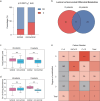Serum metabolomic profiling for predicting therapeutic response and toxicity in breast cancer neoadjuvant chemotherapy: a retrospective longitudinal study
- PMID: 39762945
- PMCID: PMC11706045
- DOI: 10.1186/s13058-024-01956-w
Serum metabolomic profiling for predicting therapeutic response and toxicity in breast cancer neoadjuvant chemotherapy: a retrospective longitudinal study
Abstract
Background: Neoadjuvant chemotherapy (NACT) is the standard-of-care treatment for patients with locally advanced breast cancer (LABC), providing crucial benefits in tumor downstaging. Clinical parameters, such as molecular subtypes, influence the therapeutic impact of NACT. Moreover, severe adverse events delay the treatment process and reduce the effectiveness of therapy. Although metabolic changes during cancer treatment are crucial determinant factors in therapeutic responses and toxicities, related clinical research remains limited.
Methods: One hundred paired blood samples were collected from 50 patients with LABC before and after a complete NACT treatment cycle. Untargeted metabolomics was used by liquid chromatography-mass spectrometry (LC-MS) to investigate the relationship between dynamically changing metabolites in serum and the responses and toxicities of NACT.
Results: Firstly, we observed significant alterations in serum metabolite levels pre- and post-NACT, with a predominant enrichment in the sphingolipid and amino acid metabolism pathways. Second, pre-treatment serum metabolites successfully predicted the therapeutic response and hematotoxicities during NACT. In particular, molecular subtype variations in favorable treatment responses are linked to acyl carnitine levels. Finally, we discovered that the therapeutic effects of NACT could be attributed to essential amino acid metabolism.
Conclusion: This study elucidated the dynamic changes in metabolism during NACT treatment, providing a possibility for developing responsive metabolic signatures for personalized NACT treatment.
Keywords: Acylcarnitine; Breast cancer; Essential amino acid; Metabolomics; Neoadjuvant chemotherapy; Serum.
© 2025. The Author(s).
Conflict of interest statement
Declarations. Ethics approval and consent to participate: The serum of LABC patients was obtained from the Department of Clinical Laboratory, SAHZU. All patients provided written informed consent prior to the study. The Institutional Research Ethics Committee approved the use of clinical specimens for research purposes. Consent for publication: Not applicable. Competing of interests: The authors declare no competing interests.
Figures





References
-
- Sedeta ET, Jobre B, Avezbakiyev B. Breast cancer: Global patterns of incidence, mortality, and trends. 2023; 41(16_suppl):10528
-
- Costa R, Hansen N, Gradishar WJ. 63 - Locally Advanced Breast Cancer. In: Bland KI, Copeland EM, Klimberg VS, Gradishar WJ, editors. The Breast (Fifth Edition): Elsevier; 2018. p. 819–31.e6.
MeSH terms
Substances
Grants and funding
LinkOut - more resources
Full Text Sources
Medical

